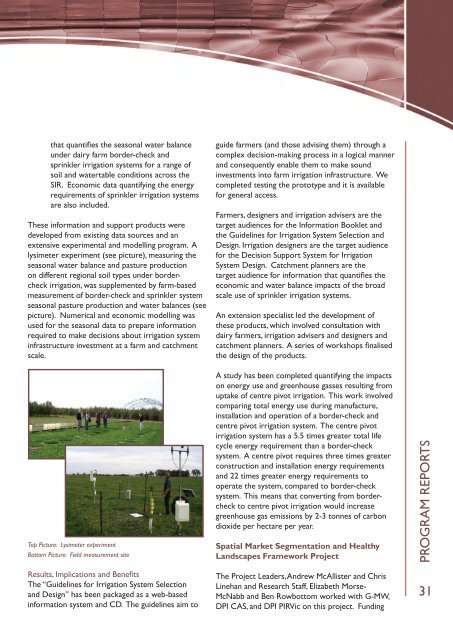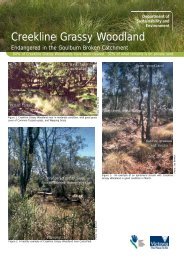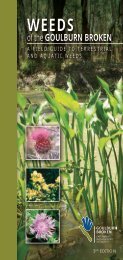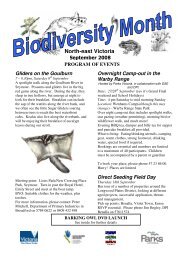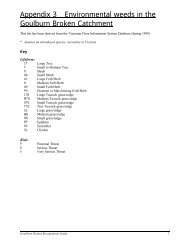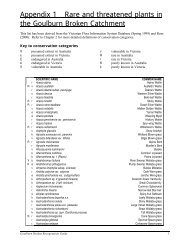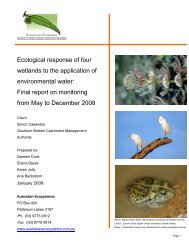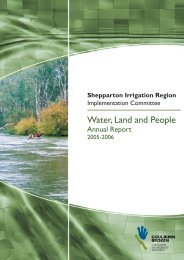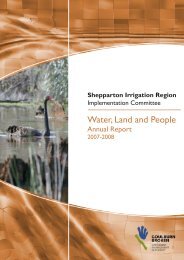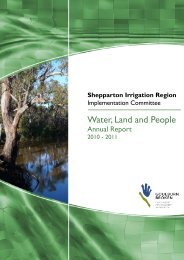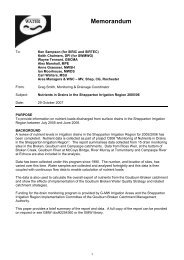Water, Land and People - Goulburn Broken Catchment ...
Water, Land and People - Goulburn Broken Catchment ...
Water, Land and People - Goulburn Broken Catchment ...
You also want an ePaper? Increase the reach of your titles
YUMPU automatically turns print PDFs into web optimized ePapers that Google loves.
that quantifies the seasonal water balance<br />
under dairy farm border-check <strong>and</strong><br />
sprinkler irrigation systems for a range of<br />
soil <strong>and</strong> watertable conditions across the<br />
SIR. Economic data quantifying the energy<br />
requirements of sprinkler irrigation systems<br />
are also included.<br />
These information <strong>and</strong> support products were<br />
developed from existing data sources <strong>and</strong> an<br />
extensive experimental <strong>and</strong> modelling program. A<br />
lysimeter experiment (see picture), measuring the<br />
seasonal water balance <strong>and</strong> pasture production<br />
on different regional soil types under bordercheck<br />
irrigation, was supplemented by farm-based<br />
measurement of border-check <strong>and</strong> sprinkler system<br />
seasonal pasture production <strong>and</strong> water balances (see<br />
picture). Numerical <strong>and</strong> economic modelling was<br />
used for the seasonal data to prepare information<br />
required to make decisions about irrigation system<br />
infrastructure investment at a farm <strong>and</strong> catchment<br />
scale.<br />
Top Picture: Lysimeter experiment<br />
Bottom Picture: Field measurement site<br />
Results, Implications <strong>and</strong> Benefits<br />
The “Guidelines for Irrigation System Selection<br />
<strong>and</strong> Design” has been packaged as a web-based<br />
information system <strong>and</strong> CD. The guidelines aim to<br />
guide farmers (<strong>and</strong> those advising them) through a<br />
complex decision-making process in a logical manner<br />
<strong>and</strong> consequently enable them to make sound<br />
investments into farm irrigation infrastructure. We<br />
completed testing the prototype <strong>and</strong> it is available<br />
for general access.<br />
Farmers, designers <strong>and</strong> irrigation advisers are the<br />
target audiences for the Information Booklet <strong>and</strong><br />
the Guidelines for Irrigation System Selection <strong>and</strong><br />
Design. Irrigation designers are the target audience<br />
for the Decision Support System for Irrigation<br />
System Design. <strong>Catchment</strong> planners are the<br />
target audience for information that quantifies the<br />
economic <strong>and</strong> water balance impacts of the broad<br />
scale use of sprinkler irrigation systems.<br />
An extension specialist led the development of<br />
these products, which involved consultation with<br />
dairy farmers, irrigation advisers <strong>and</strong> designers <strong>and</strong><br />
catchment planners. A series of workshops finalised<br />
the design of the products.<br />
A study has been completed quantifying the impacts<br />
on energy use <strong>and</strong> greenhouse gasses resulting from<br />
uptake of centre pivot irrigation. This work involved<br />
comparing total energy use during manufacture,<br />
installation <strong>and</strong> operation of a border-check <strong>and</strong><br />
centre pivot irrigation system. The centre pivot<br />
irrigation system has a 5.5 times greater total life<br />
cycle energy requirement than a border-check<br />
system. A centre pivot requires three times greater<br />
construction <strong>and</strong> installation energy requirements<br />
<strong>and</strong> 22 times greater energy requirements to<br />
operate the system, compared to border-check<br />
system. This means that converting from bordercheck<br />
to centre pivot irrigation would increase<br />
greenhouse gas emissions by 2-3 tonnes of carbon<br />
dioxide per hectare per year.<br />
Spatial Market Segmentation <strong>and</strong> Healthy<br />
<strong>L<strong>and</strong></strong>scapes Framework Project<br />
The Project Leaders, Andrew McAllister <strong>and</strong> Chris<br />
Linehan <strong>and</strong> Research Staff, Elizabeth Morse-<br />
McNabb <strong>and</strong> Ben Rowbottom worked with G-MW,<br />
DPI CAS, <strong>and</strong> DPI PIRVic on this project. Funding<br />
PROGRAM REPORTS<br />
31


